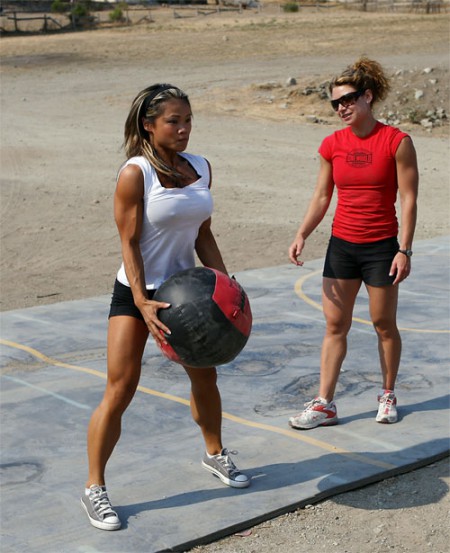Female strength training is different than a males. Is it because of gender roles or emotion? No, it’s because of the reality of physiology. You see, women have less than one tenth (1/10) of the testosterone as a male. Ehh, maybe it depends on what kind of male we’re talking about…at least guys that lift.
We understand this means women won’t get “bulky” or grow muscle like a gorilla, yet it changes how they react to training. Let’s not worry about what hormone does what — I’m not an endocrinologist and the hormone function of women is more complicated than quantum theory. Let’s just look at the resultant effects.
To Grow — Muslcesize!
Females develop muscular structure with higher repetition programs. This is an observation across many different types of training. Figure/fitness competitors typically approach training like “bodybuilding”, our quick summation of higher repetition training in both compound and isolation exercises and lifts. Many are quick to say, “Yeah, and they’re on steroids/PEDs,” but look at their training modality. It typically hits a lot of reps in a compound movement, then moves to more isolation work on the same muscles in the same session. It puts a lot of work and volume on that area.
 Now look at something like CrossFit. It’s an amusing stereotype to say, “CrossFit turns the men into women and the women into men.” It’s a bit unfair, but it sort of holds true. Go to bigger, higher performing facilities and you’ll see beautifully muscled women (which makes them look shapely and womenly as opposed to bulky or extremely muscular) who might be working along side shredded guys who weigh only 20 or 30 pounds more than that girl. Again, this isn’t entirely fair since the higher performing male athletes are anywhere from 190 to 220 pounds, but this isn’t about the guys. The women develop good musculature in CrossFit because a) they’re performing effecitve compound movements and b) they are doing them with high repetitions.
Now look at something like CrossFit. It’s an amusing stereotype to say, “CrossFit turns the men into women and the women into men.” It’s a bit unfair, but it sort of holds true. Go to bigger, higher performing facilities and you’ll see beautifully muscled women (which makes them look shapely and womenly as opposed to bulky or extremely muscular) who might be working along side shredded guys who weigh only 20 or 30 pounds more than that girl. Again, this isn’t entirely fair since the higher performing male athletes are anywhere from 190 to 220 pounds, but this isn’t about the guys. The women develop good musculature in CrossFit because a) they’re performing effecitve compound movements and b) they are doing them with high repetitions.
If you want musculature to grow, or become shapely, then perform higher reps. This is easily done in a strength program by doing a some back off sets with higher repetitions after the initial work sets are done (or by adding in appropriately structured conditioning work).
Higher Percentages?
It’s noticeable that females can not only do more work than their male counterparts, but can lift more reps at a higher percentage of their max. These two concepts exist because of the hormonal differences which make a female’s neuromuscular efficiency lower than a male’s. This is a term that indicates how efficiently motor units function. A motor unit consists of a group of muscle fibers that are innervated by the same motor neuron. How many muscle fibers that a motor neuron is connected to is dependent on the type of muscle. For example, the gastrocnemius (hoof-looking portion of the calf) has around 2,000 muscle fibers while some optic muscles (in the eye) only have a few. The fewer the muscle fibers, the more precise and deft the movement (think of the delicate movements of the fingers compared to the knee).
When a motor neuron reaches its action potential, all of the fibers associated with it will innervate (this is the “all-or-none law”). However, given a movement, not all motor units will be activated. Neuromuscular efficiency depends on the number of motor units, the rate of activation, and how the innervation functions with other muscle groupings (including antagonistic muscles).
The hell does all of that mean? A greater neuromuscular efficiency means that the body is more efficient at applying force and executing movement. It’s the same reason why a new trainee might awkwardly execute a herky-jerky squat, but then after getting plenty of repetitions (i.e. practice), their technique will smooth into efficient mechanics.
In the case of a woman, it means that she is never truly applying as much force as her muscles can because her motor neurons can’t innervate everything properly to do so. When a girl hits 90% of her max for 5 or 6 reps (something that a guy might hit for a set of 3), it’s because what we are calling 90% is actually lower than what her true 90% is. Women can lift more reps with higher percentages than men because they aren’t as neuromuscularly efficient as men.
A women’s training will need to be modified beyond the “novice stages” to account for this difference in efficiency. In the Texas Method, for example, a women can (and will need to) use a greater intensity on her Volume Day in order to get enough of a stress. If you’ve read my books, you know that the average intensity of the Volume Day shouldn’t exceed about 85% of the Intensity Day’s (i.e. if the Intensity day is 500×3, then the average of the Volume Day work sets shouldn’t be much higher than 425). But a female can handle 85% but eventually will need a greater percentage to get an adaptive stress. For example, if a female is squatting 225×3, her Volume Day sets could approach 90%, which is around 200x5x3.
Note: These percentages are not calculating total volume and they are relative to the weight that is done on the Intensity Day. They are just a gauge for controlling the programming. If you’re confused or want to know more, then purchase the books.
This same concept will apply in other programs, but as coaches we need to take note, especially in maximal lifting scenarios. If a girl looks good on a heavy set of 5, we may think in “male terms” and think she has a lot of weight left on the bar for a 1RM. Yet her 1RM is going to be closer to her 5RM and 3RM than a guy’s. This is important to know in preparing attempts for a meet, but also choosing third attempts based on difficulty. If a second attempt looks regular, that female may not be able to make as large of a jump as you (and she) think she can. You women have probably noticed this; you’ll do a rep at a heavy weight and it feels fine. Then you go up ten pounds and you get stapled. It all has to do with neuromuscular efficiency. Women will vary in how much this effects them, but as a general rule the efficiency is lower than in their male counterparts. Experience will be the ultimate deciding factor, but in the mean time, be a bit conservative.
Since a woman is typically using a lower percentage of her max, she can handle more work than a guy would. This is noticeable when a gal isn’t necessarily fatigued after sets, or doesn’t seem fatigued throughout the session (sometimes this is the case because she’s limited on what she can do with correct technique). It’s not a big deal for women to tack on additional assistance exercises or high intensity conditioning; she’ll be able to recover and the higher repetitions will probably augment her strength gains.
Take note of these various important points: 1) women grow with reps, 2) women can complete more reps with high percentages of 1RM, 3) a woman’s 1RM ceiling doesn’t extend much beyond her rep maxes, and 4) a woman can handle more work in the programming. I hate the fact that I have to say this, but you guys leave me no choice: this doesn’t apply to everyone in every situation. However, on average it will be the case and knowing about these issues can help program strength or aesthetic improvements.



Good post. I’ve notice this in my female clients. You’re working up to a heavy single and 10lbs more seems to swingline them. I assumed it a was a gender variation, part nature and part nurture, as most women have limited experience in exerting brute force and lack the experience in recruiting the neurons to apply it. Nice to know the background on it.
“But a female can handle 85% but eventually will need a greater percentage to get an adaptive stress. For example, if a female is squatting 225×3, her Volume Day sets could approach 90%…”
My female training partner is just about to transition into the TM and, after revising PP, I had literally just drawn the very same conclusion and told her we’d start her VD at 85% of her ID, but be prepared to increase it up closer to 90%. Good to see I know what I’m talking about! Thanks for another useful female training post.
Cool topic. Here’s a long-ass question:
What kind of cumulative effect on one’s training would this have in the long term? Consider two women. Woman A has a lower neuromuscular efficiency than Woman B. At T0, they’re both squatting the same weight for a 5RM. But because Woman A is less efficient than Woman B, she can consistently work closer to her 1RM than Woman B on Volume Day. At T1 (say, a year later), would Woman A have a higher 1RM than Woman B, all other things being equal (which they never are)?
Or, alternatively, would Woman A need to consistently work harder on Volume Day to see the same gains as Woman B on Intensity Day?
I think it’s a mistake to put A and B in different categories. As a gender, they aren’t going to have significant differences in the way that you indicate.
To answer your question, I don’t know. If B had noticeably better efficiency, I’d expect her to get stronger faster.
In practice, you’ll just have women that are stronger than others, not something like this. Even someone like Eva Twardokens still has the same fundamental stuff to deal with.
So over the summer I was teaching a female friend of mine how to lift while doing one of the SS variants. What you’re talking about in this article, would it be the reason for her to hit all 3 sets of 5 easily one day, and when coming back 2 days later, 5 extra pounds would staple her on like the first rep?
In my opinion, the situation you describe is her lack of protein intake. I don’t have to ask to know that it wasn’t adequate.
Probably true. She’s still struggling to get out of the mindset about getting bulky, and the misinformed nutritional advice the media pumps out. Plus she still took quite a while to learn how to keep herself tight while doing movements, as she had never done something like that before in her life.
Would it make sense to shift from 3 set of 5 to 5 sets of 3 as a female trainee, who has adequate protein intake, nears the end of her linear progression?
If you think it’ll help extend her progression.
With females, sometimes it’s more about accumulating stress from lifting over a long period of time. For example, if she squatted twice a week for a year, it would be better than to increase the weight every session for her muscular and strength development. In other words, the fact that she’s squatting twice a week is more important than the weight on the bar. It’ll depend on the gal and her goals as to which approach should be taken, but just keep that in mind.
This is very helpful. I coach a ton of girls and constantly have to back the weights off. They get a little greedy and then miss the next work weight. If you think it’s hard to get a 20 something or older girl to eat enough protein, try convincing a 15-18yo they need to eat more and gain some weight. Near impossible.
I’ve transitioned a few to the TM for more practice on solid squats following what you said about some other trainees. My goal is to have them squat several times a week for a long period of time. For those who have been consistent, although the weight on the bar is not huge, their confidence and appearance have changed drastically. I call that a win.
Have you ever given thought to writing a book/ebook specifically geared toward training women or programming for women?
I thought this was pretty 70sBig: http://imgur.com/gallery/AF5C4
on the one hand, it’s great to know i’m not just doing it wrong when i add 5-10lbs to my working weight and get flattened by it (and usually this happens after fairly easily completing the reps at the lighter weight). i sort of knew what was happening from the posts on female progressions on the SS boards, but this post was much more comprehensive. so thanks for that!
on the other hand, it’s another reason to hate my ovaries.
I think I’d found the same posts on the SS boards and decided to do all my sets as sets of 3’s instead of 5’s, but the total same amount of reps for the workout, so more sets. I’m doing some sort of of TM as suggested to me by fiance (I’m a terrible person and haven’t read the books), but it’s been working really really well for me. So many times when I was doing linear progression I’d be able to get 2-3 reps at a weight, but never a full 5 so I was constantly stalling/deloading (to be fair, also wasn’t eating enough protein during that time).
http://www.youtube.com/watch?feature=player_embedded&v=rdC5tBGvh_Y from allthingsgym, she has a max snatch of 106kg or so ..just an example for this post. Thanks for all the info it was a great read
Thanks for explaining that!
I’d been wondering WTF was up with that! I figured I must not be strong enough yet and was somehow screwing up my 1RM… on every single lifting session. :P
Interesting stuff — thanks for the explanation. The 5RM-close-to-1RM phenomenon is very descriptive of my upper body lifts, but less so for lower body stuff, particularly deadlifts. I can’t do heavy pulls for reps, despite my ovaries. Anyway, I appreciate the info.
With this data in mind I’ve recently upped my TM volume percentage to just over 90%. Looking forward to seeing how it works over time – so far it’s only been about a month.
Also thanks for the information on growing muscle. If I could get “bulky” I’d be all over that. But at least maybe I can move from skinny legs to thunder thighs with a little extra work. :-)
I’d love me some bulky arms so these batwings in my armpits go away
Pingback: Time Me | Cannon Crossfit
Love this. The percentages are interesting and admitting truth where it’s mentioned is refreshing. Great perspective in this post, and the gorilla photos up the awesomeness. Look forward to reading more in the future!
Pingback: Derby City CrossFit | Louisville | Workout of the Day – Saturday 9/1/12
Pingback: 9-3-12 « Sage-Fitness
Pingback: Why Females Lift Less Efficiently | 70's Big
Justin, do you think that a male having a 5rm that is a higher percentage of their 1rm could be a symptom of low testosterone? When I was younger (25-29) I used to be able to use the (reps x work-weight x .0333)+work-weight = max for bench and come really close. Now that I’m older (37), I’m finding that I can’t bench what my reps at 225 would suggest under that formula. One other fact is that I used to test my max relatively regularly and stopped doing that for a very long time. So, my question is basically: Am I turning into a woman, or do I just need to start lifting more at higher percentages of my max?
Pingback: Barbells At The New Craptastic | theclothesmakethegirl
Pingback: m’s digest // training & intensity, peculiarities of female training, rose water macaroons with pistachio custard…
Pingback: Strength Monday 03/04/13 (w/ Bonus Badassery) | theclothesmakethegirl